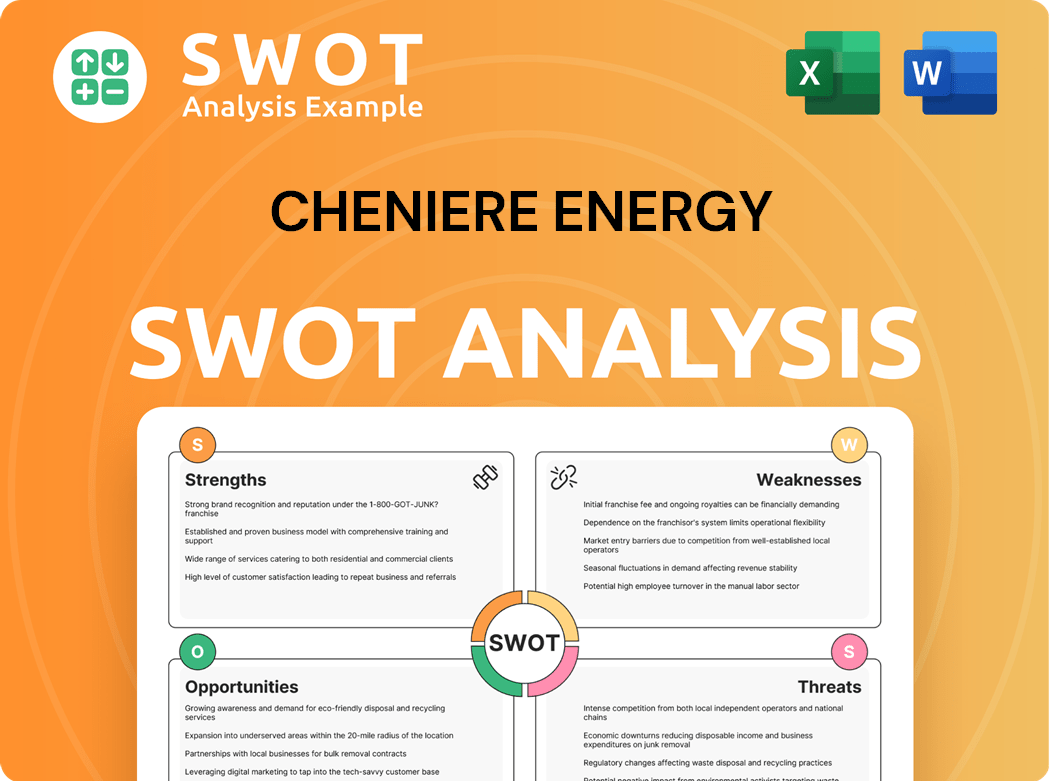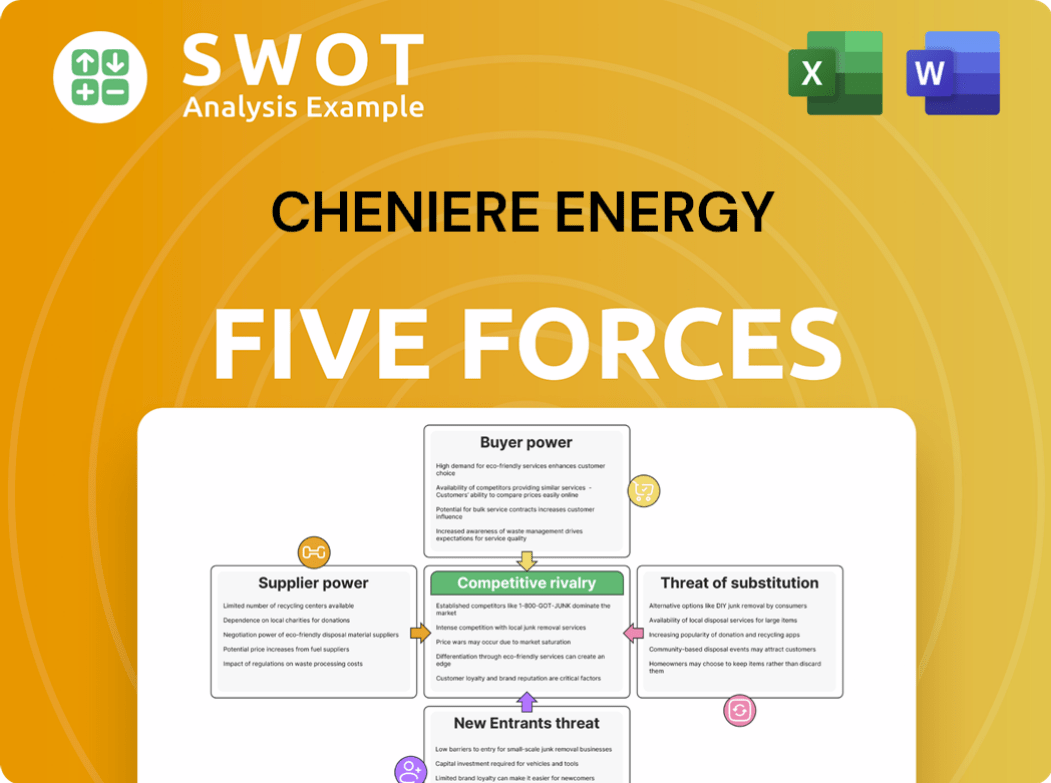Cheniere Energy Bundle
How Does Cheniere Energy Stack Up in the LNG Arena?
The Cheniere Energy SWOT Analysis reveals a company at the forefront of a rapidly evolving global energy market. As the LNG industry reshapes the energy sector, understanding Cheniere Energy's competitive landscape is crucial. This analysis dives deep into Cheniere Energy's market positioning, its key rivals, and the factors that will determine its future success.

This exploration of the Cheniere Energy competitive landscape provides essential insights for investors and strategists alike. We'll dissect Cheniere Energy's market share analysis, comparing its financial performance against competitors in the natural gas market. Furthermore, we'll examine its competitive advantages, strategic partnerships, and the impact of geopolitical events on Cheniere Energy, offering a comprehensive view of its position in the global LNG market.
Where Does Cheniere Energy’ Stand in the Current Market?
Cheniere Energy holds a significant position in the liquefied natural gas (LNG) market. It operates as a leading producer and exporter of LNG from the United States. The company's strategic focus on LNG export terminals has allowed it to become a key player in the global energy supply chain.
The company's core operations involve the liquefaction and export of natural gas, primarily from its terminals. Cheniere Energy capitalizes on the price differences between U.S. natural gas and international LNG markets. This strategic advantage contributes to its financial performance and market position.
Cheniere Energy's value proposition lies in its ability to provide a reliable supply of LNG to international markets. It offers a crucial link in the global energy supply chain, particularly for countries seeking to diversify their energy sources. This is a key factor in its competitive landscape.
Cheniere Energy's LNG export terminals, including Sabine Pass and Corpus Christi, have a combined nominal production capacity of approximately 45 million tonnes per annum (mtpa). This substantial capacity makes it a major exporter in the LNG industry. This capacity is a key aspect of Cheniere Energy's competitive landscape.
In 2023, Cheniere's terminals accounted for a significant portion of U.S. LNG exports. This solidifies its role as a critical link in the global energy supply chain. The company's financial health is robust, reflected in its strong revenue generation and consistent profitability.
Cheniere Energy primarily serves international markets, with significant volumes directed towards Europe and Asia. This is driven by energy security concerns and the increasing demand for natural gas. The company's strategic positioning enables it to capitalize on arbitrage opportunities.
The company's strong financial performance allows for continued investment in infrastructure and expansion projects. This financial strength is crucial for maintaining its competitive edge. For more details, you can explore Owners & Shareholders of Cheniere Energy.
Cheniere Energy benefits from several competitive advantages in the natural gas market. These include its strategic location, substantial export capacity, and strong financial performance. These factors contribute to its success in the LNG industry.
- Dominant position in U.S. LNG exports.
- Significant LNG export capacity of approximately 45 mtpa.
- Strong financial performance and consistent profitability.
- Strategic partnerships and long-term contracts.
Cheniere Energy SWOT Analysis
- Complete SWOT Breakdown
- Fully Customizable
- Editable in Excel & Word
- Professional Formatting
- Investor-Ready Format

Who Are the Main Competitors Challenging Cheniere Energy?
The Cheniere Energy competitive landscape is shaped by a dynamic global natural gas market. Understanding Cheniere Energy competitors is crucial for evaluating its market position and future prospects. The company faces competition from established energy giants and emerging players in the LNG industry.
Cheniere Energy's market analysis reveals a complex interplay of direct and indirect competitors. Factors such as geopolitical events and technological advancements further influence the competitive environment. Analyzing these elements provides insights into Cheniere Energy's challenges and opportunities.
The competitive environment for Cheniere Energy is multifaceted, involving both direct and indirect competitors. Direct competitors are primarily other LNG exporters, while indirect competition comes from alternative energy sources. The company's success depends on its ability to navigate this complex landscape and maintain a competitive edge. Learn more about Revenue Streams & Business Model of Cheniere Energy to understand how it generates income.
Cheniere Energy's main rivals include major players in the global LNG market. These companies compete for market share through production capacity, long-term contracts, and strategic partnerships. The competitive landscape is constantly evolving, with new projects and alliances emerging regularly.
QatarEnergy is a significant competitor due to its massive production capacity and long-term contracts. It is a state-owned enterprise and a dominant force in the global LNG supply. QatarEnergy's extensive infrastructure and strategic partnerships give it a strong competitive advantage.
Shell operates a vast portfolio of LNG assets globally, including liquefaction, shipping, and regasification. Its integrated operations and global presence make it a formidable competitor. Shell's diverse portfolio allows it to adapt to market fluctuations and maintain a strong position.
Chevron and ExxonMobil leverage their integrated oil and gas operations to participate in the LNG value chain. Their extensive resources and global reach enable them to compete effectively in the LNG market. These companies have significant financial backing and operational expertise.
Indirect competition comes from other energy sources like pipeline natural gas, coal, and renewable energy. These alternatives can influence the demand for LNG in various markets. The availability and cost of these alternatives impact Cheniere Energy's market share.
New and emerging players developing additional liquefaction capacity in the U.S. and other regions also pose a competitive challenge. These companies can disrupt the market by offering competitive pricing and innovative solutions. The entry of new players increases the overall competitive intensity.
The Cheniere Energy competitive landscape is shaped by several factors, including strategic partnerships and geopolitical events. Cheniere Energy's expansion plans and operational efficiency are crucial for maintaining its competitive edge. Understanding these dynamics is essential for evaluating the company's performance.
- Strategic Partnerships: Companies often form alliances to enhance capabilities and consolidate market share.
- Geopolitical Events: These events can significantly impact LNG supply and demand, affecting Cheniere Energy's challenges and opportunities.
- Expansion Plans: The ongoing development of new LNG projects globally intensifies competition.
- Market Access: Companies compete for long-term supply contracts and access to key markets.
- Operational Efficiency: Cheniere Energy's operational efficiency and cost management are critical for maintaining profitability.
Cheniere Energy PESTLE Analysis
- Covers All 6 PESTLE Categories
- No Research Needed – Save Hours of Work
- Built by Experts, Trusted by Consultants
- Instant Download, Ready to Use
- 100% Editable, Fully Customizable

What Gives Cheniere Energy a Competitive Edge Over Its Rivals?
Understanding the competitive landscape of Cheniere Energy requires a close look at its strengths. The company has carved out a significant position in the LNG industry. Key to its success are its strategically located terminals and operational expertise. This positions it favorably within the natural gas market.
Cheniere Energy's competitive advantages are rooted in its infrastructure and business model. Its terminals, like Sabine Pass and Corpus Christi, are among the largest globally, offering efficient operations. The company's approach to contracts provides stable revenue streams, which sets it apart from competitors. For a detailed look at the company's growth strategy, see Growth Strategy of Cheniere Energy.
The company's early entry into U.S. LNG exports has given it a head start. This early mover advantage, combined with high barriers to entry, helps sustain its competitive edge. These factors contribute to Cheniere Energy's strong standing in the energy sector.
Cheniere Energy's infrastructure, including its Sabine Pass and Corpus Christi terminals, is a major competitive advantage. These terminals have significant LNG export capacity. This capacity is a key factor in the company's market share analysis.
Operational efficiency is a core strength for Cheniere. The company's experience in managing large-scale liquefaction facilities contributes to its competitive edge. This operational expertise is crucial in the LNG industry.
Cheniere's business model, based on long-term contracts, provides stable revenue. This approach helps mitigate the impact of short-term price volatility. This contractual framework attracts international customers.
Cheniere's early entry into the U.S. LNG export market is a significant benefit. This early mover advantage has allowed the company to establish key infrastructure and relationships. It has helped them gain a strong position in the global LNG market.
Cheniere Energy's competitive advantages include its strategic infrastructure, operational expertise, and contractual framework. These factors contribute to its strong market position. The company's ability to secure long-term contracts and manage large-scale facilities sets it apart.
- Access to low-cost U.S. natural gas reserves through extensive pipeline networks.
- Efficient operations at its terminals, enhancing reliability and cost-effectiveness.
- A business model focused on take-or-pay contracts, ensuring stable revenue streams.
- Early establishment of infrastructure and relationships, creating barriers to entry.
Cheniere Energy Business Model Canvas
- Complete 9-Block Business Model Canvas
- Effortlessly Communicate Your Business Strategy
- Investor-Ready BMC Format
- 100% Editable and Customizable
- Clear and Structured Layout

What Industry Trends Are Reshaping Cheniere Energy’s Competitive Landscape?
Understanding the Cheniere Energy competitive landscape involves assessing its position within the dynamic LNG industry. The company faces both established and emerging Cheniere Energy competitors in the global natural gas market. A comprehensive Cheniere Energy market analysis reveals key trends, challenges, and opportunities shaping its future in the energy sector.
The Cheniere Energy's position in the global LNG market is significant due to its early mover advantage in the U.S. LNG export market. However, the company must navigate risks related to market volatility and geopolitical factors. Strategic foresight and operational excellence are crucial for maintaining its competitive edge. For more information on the target market, you can read the article about the Target Market of Cheniere Energy.
The LNG industry is experiencing increased global demand, driven by energy security concerns and the transition to lower-carbon fuels. Technological advancements in liquefaction and shipping are enhancing efficiency and reducing costs. Regulatory changes, particularly those related to emissions, are influencing market dynamics.
Increased global LNG supply could intensify competition and put downward pressure on prices. Natural gas price volatility, although mitigated by contracts, remains a factor. Geopolitical shifts and trade policies can also impact LNG trade flows and demand. Compliance with stricter environmental regulations could also increase costs.
Emerging markets with growing energy needs and regions seeking to diversify energy sources present opportunities. Innovation in carbon capture and storage technologies or lower-carbon LNG production could provide avenues for growth. Strategic partnerships and expansion plans can also enhance market position.
Cheniere Energy is well-positioned to capitalize on these trends with ongoing expansion projects and a focus on operational excellence. Its existing infrastructure and long-term contracts provide a degree of stability. The company's ability to adapt to changing market conditions will be critical for sustained success.
Cheniere Energy faces a competitive landscape with several key players. The company’s financial performance is closely watched, with its stock performance often compared to competitors. Cheniere Energy's challenges and opportunities are intertwined with its strategic partnerships and expansion plans.
- Cheniere Energy's main rivals include major international oil and gas companies and other LNG exporters.
- Cheniere Energy market share analysis reveals its significant presence in the U.S. LNG export market.
- Competitive advantages of Cheniere Energy include its infrastructure, long-term contracts, and operational efficiency.
- Cheniere Energy's LNG export capacity is a critical factor influencing its revenue streams and overall financial performance.
Cheniere Energy Porter's Five Forces Analysis
- Covers All 5 Competitive Forces in Detail
- Structured for Consultants, Students, and Founders
- 100% Editable in Microsoft Word & Excel
- Instant Digital Download – Use Immediately
- Compatible with Mac & PC – Fully Unlocked

Related Blogs
- What are Mission Vision & Core Values of Cheniere Energy Company?
- What is Growth Strategy and Future Prospects of Cheniere Energy Company?
- How Does Cheniere Energy Company Work?
- What is Sales and Marketing Strategy of Cheniere Energy Company?
- What is Brief History of Cheniere Energy Company?
- Who Owns Cheniere Energy Company?
- What is Customer Demographics and Target Market of Cheniere Energy Company?
Disclaimer
All information, articles, and product details provided on this website are for general informational and educational purposes only. We do not claim any ownership over, nor do we intend to infringe upon, any trademarks, copyrights, logos, brand names, or other intellectual property mentioned or depicted on this site. Such intellectual property remains the property of its respective owners, and any references here are made solely for identification or informational purposes, without implying any affiliation, endorsement, or partnership.
We make no representations or warranties, express or implied, regarding the accuracy, completeness, or suitability of any content or products presented. Nothing on this website should be construed as legal, tax, investment, financial, medical, or other professional advice. In addition, no part of this site—including articles or product references—constitutes a solicitation, recommendation, endorsement, advertisement, or offer to buy or sell any securities, franchises, or other financial instruments, particularly in jurisdictions where such activity would be unlawful.
All content is of a general nature and may not address the specific circumstances of any individual or entity. It is not a substitute for professional advice or services. Any actions you take based on the information provided here are strictly at your own risk. You accept full responsibility for any decisions or outcomes arising from your use of this website and agree to release us from any liability in connection with your use of, or reliance upon, the content or products found herein.